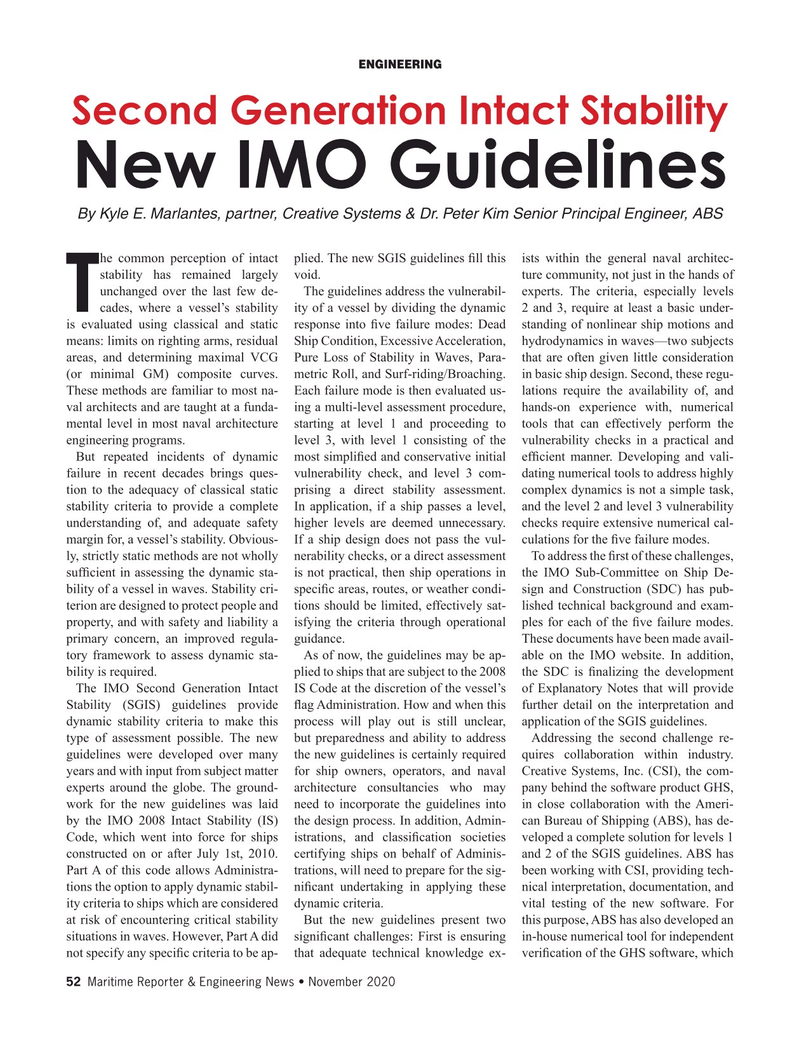
Page 52: of Maritime Reporter Magazine (November 2020)
Workboat Edition
Read this page in Pdf, Flash or Html5 edition of November 2020 Maritime Reporter Magazine
ENGINEERING
Second Generation Intact Stability
New IMO Guidelines
By Kyle E. Marlantes, partner, Creative Systems & Dr. Peter Kim Senior Principal Engineer, ABS he common perception of intact plied. The new SGIS guidelines ? ll this ists within the general naval architec- stability has remained largely void. ture community, not just in the hands of unchanged over the last few de- The guidelines address the vulnerabil- experts. The criteria, especially levels
Tcades, where a vessel’s stability ity of a vessel by dividing the dynamic 2 and 3, require at least a basic under- is evaluated using classical and static response into ? ve failure modes: Dead standing of nonlinear ship motions and means: limits on righting arms, residual Ship Condition, Excessive Acceleration, hydrodynamics in waves—two subjects areas, and determining maximal VCG Pure Loss of Stability in Waves, Para- that are often given little consideration (or minimal GM) composite curves. metric Roll, and Surf-riding/Broaching. in basic ship design. Second, these regu-
These methods are familiar to most na- Each failure mode is then evaluated us- lations require the availability of, and val architects and are taught at a funda- ing a multi-level assessment procedure, hands-on experience with, numerical mental level in most naval architecture starting at level 1 and proceeding to tools that can effectively perform the engineering programs. level 3, with level 1 consisting of the vulnerability checks in a practical and
But repeated incidents of dynamic most simpli? ed and conservative initial ef? cient manner. Developing and vali- failure in recent decades brings ques- vulnerability check, and level 3 com- dating numerical tools to address highly tion to the adequacy of classical static prising a direct stability assessment. complex dynamics is not a simple task, stability criteria to provide a complete In application, if a ship passes a level, and the level 2 and level 3 vulnerability understanding of, and adequate safety higher levels are deemed unnecessary. checks require extensive numerical cal- margin for, a vessel’s stability. Obvious- If a ship design does not pass the vul- culations for the ? ve failure modes.
ly, strictly static methods are not wholly nerability checks, or a direct assessment To address the ? rst of these challenges, suf? cient in assessing the dynamic sta- is not practical, then ship operations in the IMO Sub-Committee on Ship De- bility of a vessel in waves. Stability cri- speci? c areas, routes, or weather condi- sign and Construction (SDC) has pub- terion are designed to protect people and tions should be limited, effectively sat- lished technical background and exam- property, and with safety and liability a isfying the criteria through operational ples for each of the ? ve failure modes. primary concern, an improved regula- guidance. These documents have been made avail- tory framework to assess dynamic sta- As of now, the guidelines may be ap- able on the IMO website. In addition, bility is required. plied to ships that are subject to the 2008 the SDC is ? nalizing the development
The IMO Second Generation Intact IS Code at the discretion of the vessel’s of Explanatory Notes that will provide
Stability (SGIS) guidelines provide ? ag Administration. How and when this further detail on the interpretation and dynamic stability criteria to make this process will play out is still unclear, application of the SGIS guidelines.
type of assessment possible. The new but preparedness and ability to address Addressing the second challenge re- guidelines were developed over many the new guidelines is certainly required quires collaboration within industry. years and with input from subject matter for ship owners, operators, and naval Creative Systems, Inc. (CSI), the com- experts around the globe. The ground- architecture consultancies who may pany behind the software product GHS, work for the new guidelines was laid need to incorporate the guidelines into in close collaboration with the Ameri- by the IMO 2008 Intact Stability (IS) the design process. In addition, Admin- can Bureau of Shipping (ABS), has de-
Code, which went into force for ships istrations, and classi? cation societies veloped a complete solution for levels 1 constructed on or after July 1st, 2010. certifying ships on behalf of Adminis- and 2 of the SGIS guidelines. ABS has
Part A of this code allows Administra- trations, will need to prepare for the sig- been working with CSI, providing tech- tions the option to apply dynamic stabil- ni? cant undertaking in applying these nical interpretation, documentation, and ity criteria to ships which are considered dynamic criteria. vital testing of the new software. For at risk of encountering critical stability But the new guidelines present two this purpose, ABS has also developed an situations in waves. However, Part A did signi? cant challenges: First is ensuring in-house numerical tool for independent not specify any speci? c criteria to be ap- that adequate technical knowledge ex- veri? cation of the GHS software, which 52 Maritime Reporter & Engineering News • November 2020
MR #11 (50-65).indd 52 11/9/2020 11:31:17 AM

 51
51

 53
53
